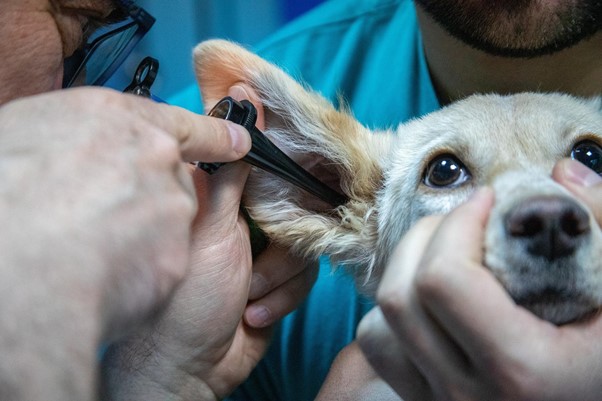How to Recognize and Treat Ear Infections in Dogs
- Last updated on April 6, 2023
- By: Caroline Stowe
Ear infections in dogs can be one of the most uncomfortable conditions for your pup. Not only are they painful, but they can also lead to permanent damage if left untreated.
That’s why it’s important to recognize the symptoms of ear infections in dogs so you can take fast, effective action to help your furry friend feel better.
Let’s explore how to recognize and treat ear infections in your canine companion.
What is Ear Infections in Dogs

Ear infections are a common problem in dogs, particularly those with long or floppy ears.
Also known as otitis external, ear infections occur when bacteria and yeast get into the outer ear canal and cause inflammation.
This can lead to itchiness, redness, and discharge from the ears.
What Are the Symptoms of an Ear Infection in Dogs ?
Head-Shaking or Tilting
One of the most noticeable symptoms of an ear infection is excessive head shaking or tilting. This is because the pain and itching associated with the infection can be quite uncomfortable for a pup.
If your dog is constantly trying to scratch their ears, this could also be a sign of an infection.
Discharge from the Ears
Another common symptom of an ear infection is discharge from the ear canal. The color and consistency of this discharge will often indicate what type of infection your dog has (bacterial or fungal).
Yellowish-green discharge with a strong odor usually indicates a bacterial infection, while a black or brown discharge with a musty smell usually indicates a fungal infection.
Itching or Scratching
Excessive itching or scratching around the ears can also be indicative of an ear infection.
This can sometimes cause redness and inflammation around the ears as well as skin irritation due to constant scratching and rubbing against furniture or other objects in order to relieve the itchiness.
Inflammation
Inflammation is another symptom that is commonly seen with ear infections in dogs.
However, it can also indicate other conditions such as allergies or mange mites so it’s important to get a proper diagnosis from your vet if you suspect any inflammation around your pup’s ears.
Redness
In addition to inflammation, redness around the ears may also indicate an ear infection.
However, again it’s important to get a proper diagnosis from your vet before attempting any treatment on your own at home as redness can also be indicative of other conditions like allergies or trauma caused by excessive head shaking/scratching/rubbing against furniture/other objects.
Loss of Balance
One lesser-known symptom associated with ear infections in dogs is loss of balance and coordination due to inner-ear damage caused by prolonged exposure to bacteria/fungus/yeast found within the infected area(s).
Unusual Odor
The presence of unusual odors coming from one or both ears may also suggest that your dog has an ear infection.
However, if you notice any strange odors coming from either side it’s best to take them to their veterinarian right away for further testing and possible treatment options depending on what type(s)of bacteria/fungus/yeast were found during examination.
Hearing Loss
Hearing loss may also occur as a result of prolonged exposure to bacteria/fungus/yeast found within the infected area(s).
This hearing loss can range from mild to severe depending on the degree of severity and how long the pet was exposed without treatment.

Pain and Discomfort
Lastly, pain and discomfort experienced by pets when touching the infected area(s)may suggest the presence of internal damage caused by prolonged exposure.
Lethargy
Finally, a pet experiencing lethargy throughout the day may suggest the presence of internal damage caused by prolonged exposure.
How Can I Diagnose My Dog's Ear Infection?
If you notice any of the symptoms mentioned above in your pup’s ears, it’s time to give them a thorough cleaning followed by a visit to the vet.
In some cases, they will recommend antibiotics or anti-inflammatory drugs to treat the infection. Your vet may also suggest other treatments such as ear drops or ointments depending on what kind of infection your pup has.
It’s important to ensure that any prescribed medication is given as instructed by your vet – skipping doses can cause bacteria or fungus to become resistant to treatment over time!
It’s important to note that some dogs have allergies or sensitivities that can cause inflammation in their ears which mimic some of the same symptoms as an infection.
This is why it’s essential that you have your pet checked out by a professional before beginning any sort of treatment plan so they can correctly diagnose the issue and provide you with appropriate care instructions for your pup!
Treatment Options for Canine Ear Infections
Cleaning and Medication
The first step in treating any type of ear infection is cleaning and medicating the ear properly. This involves using a ear cleaner solution specifically designed for cleaning your dog’s ears and then applying the medication as prescribed by your veterinarian.
Be sure to follow all instructions carefully when administering this treatment option.
Antibiotics
In some cases, antibiotics may be necessary to treat a canine ear infection. Depending on the underlying cause of the infection, these medications may be administered orally or topically through injections or drops. Be sure to consult with your vet before starting any antibiotics regimen for your pup.
Surgery
If a severe infection has developed deep within the ear canal or if there is significant damage due to long-term inflammation, surgery may be necessary to remove infected tissue or repair any damage done by the infection itself.
Surgery is typically considered a last resort and is only used in extreme cases where other treatments have proven ineffective or if there is a risk of permanent damage without intervention.
Dietary Changes
Diet can play an important role in helping manage certain types of canine ear infections such as yeast-based infections which can benefit from reducing sugar intake from commercial pet foods and sticking with fresh foods instead.
Probiotic supplements can also help improve balance within the gut flora which can further aid in reducing yeast overgrowth within your pup’s body systemically!
Essential Oils
Certain essential oils such as lavender oil have been shown to have anti-inflammatory properties that may help reduce swelling associated with some types of canine ear infections.

However, caution should always be taken when using essential oils around pets since they can be toxic if ingested or applied incorrectly!
Always dilute essential oils with carrier oils such as coconut oil before application!
Allergy Testing
Allergies are one of the most common causes of recurring ear issues in pets.
If you suspect that allergies might be playing a role in your pup’s recurrent issues then it’s best to get them tested by a qualified veterinarian who specializes in dermatology so you can determine what allergens are triggering their symptoms accurately!
Ear Plugs
For some dogs who suffer from chronic itching due to allergies or other skin conditions, wearing protective silicone plugs during baths or swimming sessions can help prevent water from entering their ears which could otherwise exacerbate their existing condition.
Additionally, this could also provide relief from constant itching during allergy season too!
Supplements
Certain supplements such as omega-3 fatty acids have been clinically proven effective at helping reduce inflammation associated with certain types of canine ear infections.
However, it’s important not only to choose products specifically formulated for veterinary use but also to make sure they are administered correctly according to package directions!
Check the video below for some home remedies to treat canine ear infections.
Prevention Tips for Avoiding Future Issues with Your Pet's Ears
Clean Regularly
One of the most important things that you can do to keep your pup’s ears healthy is to clean them regularly.
This will help prevent wax buildup and debris from collecting in the ear canal which can lead to infection or inflammation. To clean your dog’s ears, use a cotton ball or swab dipped in an ear-cleaning solution (available at most pet stores).
Gently wipe away any dirt or debris that you see in the outer part of the ear but make sure not to go too deep into the inner part of the ear canal.
Check Regularly
It is also important to check your pup’s ears regularly for any signs of irritation, redness, discharge, or odor as this could indicate an infection or other issue.
If you notice any of these symptoms, it is best to take your pup to the vet so they can diagnose and treat the problem as soon as possible.
Keep Ears Dry
After swimming or bath time, make sure that you dry your pup’s ears thoroughly with a cotton ball or towel so moisture does not get trapped inside which could lead to bacterial growth and infection.
Additionally, if your dog has long hair around their ears make sure it is trimmed back so air can circulate properly around its ears which helps keep them dry and free from bacteria and fungus.
Feed a Healthy Diet
A healthy diet is essential for keeping your pup’s body—including its ears—in tip-top shape! Providing them with nutrient-rich food will help boost their immune system which makes them less likely to get sick or develop infections in their ears (or elsewhere).
Make sure they have access to plenty of fresh water every day too as this helps flush out toxins from their body which also helps prevent infection!
Avoid Allergens
Exposure to certain allergens like pollen and mold spores can trigger allergies in some dogs which then leads them more susceptible to developing ear infections due to inflammation caused by those allergies.
If you think your dog may be allergic to something specific, talk with your vet about testing options so that you can avoid exposing them unnecessarily in order to protect their delicate ears from further irritation or infection!
Use Ear Drops
If your vet has prescribed any type of medication or drops for use in the ear, make sure that you follow instructions carefully when administering these treatments!

Many times those medications need time (sometimes up to several weeks) before they become effective so don’t forget patience here too!
Treatments should always be completed as directed by a veterinarian—never try DIY remedies at home without first consulting with a professional who knows what they’re doing when it comes to treating pups’ sensitive ear issues!
Seek Early Treatment
The sooner an underlying issue like an ear infection gets treated correctly, the better chance there is for successful resolution without lasting damage being done—so don’t wait until things get worse before seeking help from a qualified veterinarian! Catching problems early on often results in faster recovery times for our furry friends too so don’t delay if something seems amiss with those precious pooch ears!
Check Products Before Using
Before using any kind of product on/around your pet’s delicate skin/ears, make sure that it is safe/approved by veterinary professionals!
If there are any questions/concerns about safety, definitely consult with someone who knows what they’re talking about before proceeding just because it sounds like a good idea at first glance! Safety always comes first here folks!
Limit Access To Chemicals and Detergents
Dogs love exploring new places, but sometimes these explorations lead them into areas where dangerous chemicals may lurk.
Always be mindful if bringing Fido along on trips outdoors and limit exposure whenever possible! Keep household cleaners and detergents far away from curious noses and paws too!
These products are harsh on humans let alone our four-legged family members! Take care when handling potentially toxic chemicals and detergents near pets.
Keep Up With Vet Visits
Annual vet checkups are super important when it comes to keeping our furry friends feeling fit and fabulous! During visits, ask questions about anything related to health concerns including hearing-related troubles.
The more informed we are, the better chances we have to prevent potential problems down the road! Plus, it’s always nice to catch up with a trusted veterinarian each year regardless 😉
Conclusion
Ear infections can be extremely painful and uncomfortable for your pup, so recognizing them early on is key!
Take note of any odd odors coming from their ears, redness or swelling around their ears, discharge from their ears, excessive head shaking/scratching/tilting, hearing loss, or balance issues – all signs that should prompt you to contact your veterinarian immediately for treatment.
The sooner you get started on treatment for ear infections in dogs, the sooner it will clear up! With proper care and maintenance following treatment, you can help keep your furry friend healthy and happy!
-
Author: Caroline Stowe
- Updated on April 6, 2023
Disclaimer: This article doesn’t intend to replace professional veterinary advice, nor should it be used as a substitute for veterinary services, diagnosis, or treatment. The content on this website, including information and opinions expressed herein, are intended for general informational purposes only. In case you have concerns or questions regarding your dog’s health and diet requirements, please consult your veterinarian before doing anything that might affect it.
DogPetGuide.com and the writer are not responsible or liable for any damage, liability, costs, or claims arising from any possible consequences of the reader’s action after reading this article.





